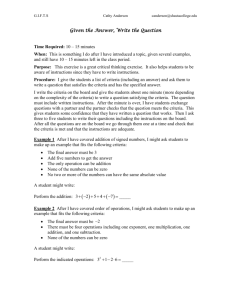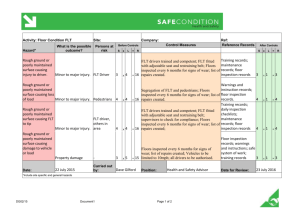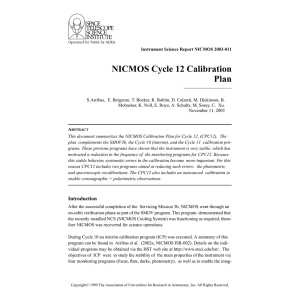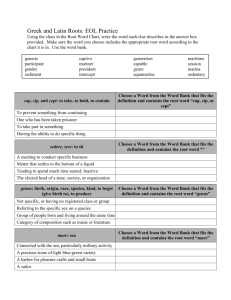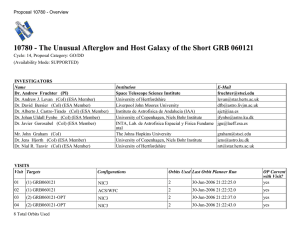NICMOS Camera 3 Pointed Flats
advertisement
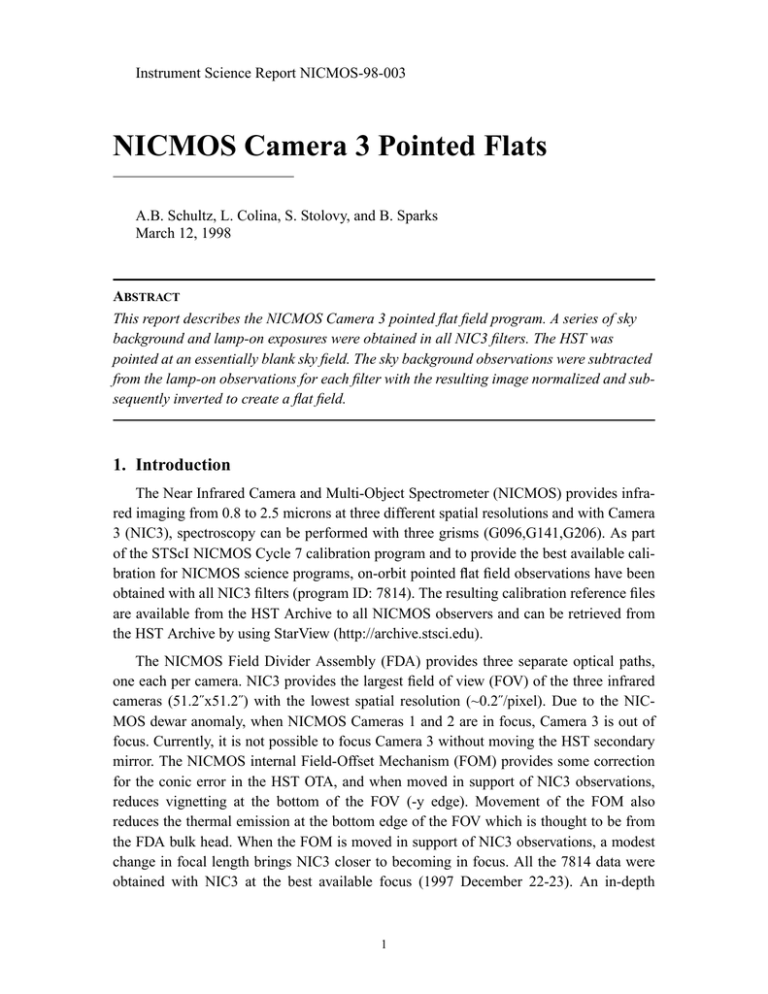
Instrument Science Report NICMOS-98-003 NICMOS Camera 3 Pointed Flats A.B. Schultz, L. Colina, S. Stolovy, and B. Sparks March 12, 1998 ABSTRACT This report describes the NICMOS Camera 3 pointed flat field program. A series of sky background and lamp-on exposures were obtained in all NIC3 filters. The HST was pointed at an essentially blank sky field. The sky background observations were subtracted from the lamp-on observations for each filter with the resulting image normalized and subsequently inverted to create a flat field. 1. Introduction The Near Infrared Camera and Multi-Object Spectrometer (NICMOS) provides infrared imaging from 0.8 to 2.5 microns at three different spatial resolutions and with Camera 3 (NIC3), spectroscopy can be performed with three grisms (G096,G141,G206). As part of the STScI NICMOS Cycle 7 calibration program and to provide the best available calibration for NICMOS science programs, on-orbit pointed flat field observations have been obtained with all NIC3 filters (program ID: 7814). The resulting calibration reference files are available from the HST Archive to all NICMOS observers and can be retrieved from the HST Archive by using StarView (http://archive.stsci.edu). The NICMOS Field Divider Assembly (FDA) provides three separate optical paths, one each per camera. NIC3 provides the largest field of view (FOV) of the three infrared cameras (51.2˝x51.2˝) with the lowest spatial resolution (~0.2˝/pixel). Due to the NICMOS dewar anomaly, when NICMOS Cameras 1 and 2 are in focus, Camera 3 is out of focus. Currently, it is not possible to focus Camera 3 without moving the HST secondary mirror. The NICMOS internal Field-Offset Mechanism (FOM) provides some correction for the conic error in the HST OTA, and when moved in support of NIC3 observations, reduces vignetting at the bottom of the FOV (-y edge). Movement of the FOM also reduces the thermal emission at the bottom edge of the FOV which is thought to be from the FDA bulk head. When the FOM is moved in support of NIC3 observations, a modest change in focal length brings NIC3 closer to becoming in focus. All the 7814 data were obtained with NIC3 at the best available focus (1997 December 22-23). An in-depth 1 description of NICMOS can be found in the NICMOS Instrument Handbook (J.W. MacKenty, Version 2.0, June 1997). 2. Observations NICMOS Cycle 7 calibration program 7814 obtained images with all NIC3 filters. The program 7814 executed as a Continuous Viewing Zone (CVZ) program (22-23 December 1997) following the commanding update to move the FOM for NIC3 alignments (1997 December 8). Sky images are needed to sample the background. The background observations of identical exposure times as the lamp-on observations are sufficient for this purpose. Background observations were obtained first followed by lamp-on observations. The data were obtained using MULTIACCUM mode with a nine position spiral dither pattern. For MULTIACCUM observations, calnica will reject cosmic ray hits and saturated pixels. Table 1. NICMOS Camera 3 Filters Name Wheel Position Central Wavelength (microns) Bandwidth (microns) F108N 4 1.083 1% F110W 2 1.100 0.800-1.400 F113N 5 1.130 1% F150W 9 1.500 1.100-1.900 F160W 6 1.600 1.400-1.800 F164N 8 1.644 1% F166N 7 1.660 1% F175W 20 1.750 1.200-2.300 F187N 11 1.875 1% F190N 12 1.900 1% F196N 13 1.962 1$ F200N 14 2.000 1% F212N 18 2.121 1% F215N 19 2.150 1% F222M 15 2.225 2.150-2.300 F240M 16 2.400 2.300-2.500 2 3. Creating NIC3 Flat Fields The STSDAS tasks calnica, mscombine, msstat, and msarith were used to perform the calibration and image processing. The background and lamp-on observations were recalibrated setting calibration switches FLATCORR=OMIT, UNITCORR=PERFORM, and PHOTCALC=OMIT. By setting UNITCORR=PERFORM, the images were normalized to the exposure times. The data headers were also checked and if necessary edited to use the synthetic darks and the latest version of the NIC3 linearity file (h7n1654cn_lin.fits). All other calibration switches were set to perform. The Camera 3 flat field response for three filters is presented in Figure 1. The dark band at the bottom of the images, about ~15-20 rows, is due to shading by the Field Divider Assembly (FDA) mask. The observed vignetting results from this mask. The dark spots result from “grot” and the bright triangular region is observed in all Camera 3 flat field observations. The large scale rippling is possibly due to different pixel response and the manufacturing process used to create the detector. Figure 1: Flat Field response for Camera 3, from left to right F110W, F160W, and F222M filters. A list of 9 images (one set each per filter for background and lamp-on observations) were input into mscombine. The mscombine task performs a coaddition, filters out bad pixels, and rejects deviate pixels. The imcalc task was used to set DQ bits to a value of 32 when no samples were used when combining images. An identical reduction process was used to create Cameras 1 and 2 flat fields. In the following listing of mscombine parameters, the “gain” was set to 6.5 for Camera 3 data. The gain parameter is used for clipping deviate pixels (noise rejection). 3 Sample mscombine parameters PACKAGE = mstools TASK = mscombine input = @nic2_pol240l_lamp.lis >List of file names to combine output = n43k030b0_mos >Output file name (dqbits = ) >DQ bits to reject input pixels (pset) (nsmod_e= no) >Use noise model for computing errors ? (reject = ccdcrrej) >Type of rejection (combine= average) >Type of combine operation (weight = none) >Type of weighting scheme (nsmod_w= no) >Use noise model for weighting ? (blank = 0.) >Output value when zero pixels survive (scale = median) >Image scaling (zero = none) >Image zero level offset (statsec= ) >Image section for computing statistics (expname= SAMPTIME) >Image header exposure time keyword (lthresh= INDEF) >Lower threshold (hthresh= INDEF) >Upper threshold (nlow = 1) >minmax: Number of low pixels to reject (nhigh = 1) >minmax: Number of high pixels to reject (nkeep = 1) >Min. to keep (pos) or max. to reject (neg) (mclip = yes) >Use median in clipping algorithms ? (lsigma = 3.) >Lower sigma clipping factor (hsigma = 3.) >Upper sigma clipping factor (rdnoise= 30) >Readout noise (electrons) (gain = 5) >Gain (electrons/DN) (snoise = 0.) >Sensitivity noise (fraction) (tempdir= tmp$) >Directory for temporary files (version= 07May97) >Date of installation (mode = al) The combined background image was subtracted from the combined lamp-on observation using the task msarith. The resulting image was normalized by ratioing with the mean value of this image. msstat was used to determine the mean of the image area [1:256,56:256]. For calibration, NICMOS observations are multiplied by a flat. Therefore, the normalized image was inverted using msarith to create the flat field. A list of the 7814 NIC3 flat fields is presented in Table 2. The STSDAS mstools package of tasks (msarith, mscombine, msstat) preserves the file structure of FITS files with extensions and image sets. Each NICMOS image set has 5 extensions (SCI, ERR, DQ, SAMP, TIME). The resulting flat field image will contain a logical .OR. of all the DQ input bits, all the DQ bits from all the images used to create the flat field. The SAMP-SEQ, NSAMP, LAMP, and “exptime” used for the 7814 calibration program are listed in Table 2. The on-orbit mean count rates for each filter observation, from the lamp-on observations, are listed in Table 2 and were calculated using the integration times and the mean fluxes in the area [1:256,56:256]. 4 Table 2. Calibration program 7814 - NIC3 Flat Fields. Flat Field Filter SAMP-SEQ NSAMP & Lamp EXPTIME (sec) MEAN cts/sec i191346kn_flt.fits F108N STEP16 8&1 31.9651 197.71 i191346ln_flt.fits F110W SCAMRR 6&2 1.2180 4630.40 i191346mn_flt.fits F113N STEP16 8&1 31.9651 227.53 i191346nn_flt.fits F150W SCAMRR 6&2 1.2180 4817.81 i191346on_flt.fits F160W MCAMRR 9&2 2.7209 2172.16 i191346pn_flt.fits F164N STEP8 8&1 23.965 253.81 i191346qn_flt.fits F166N STEP8 8&1 23.965 238.17 i191346rn_flt.fits F175W SCAMRR 6&2 1.2180 5122.70 i191346sn_flt.fits F187N STEP16 8&1 31.9651 202.83 i191346tn_flt.fits F190N STEP16 8&1 31.9651 206.79 i1913470n_flt.fits F196N STEP16 8&1 31.9651 205.76 i1913471n_flt.fits F200N STEP16 8&1 31.9651 204.81 i1913472n_flt.fits F212N STEP16 8&1 31.9651 180.53 i1913473n_flt.fits F215N STEP16 8&1 31.9651 160.78 i1913474n_flt.fits F222M STEP1 7&1 4.9834 1091.80 i1913475n_flt.fits F240M STEP1 6&1 3.9858 1411.00 4. One orbit monitor visit The first NIC3 Campaign, moving the HST secondary to bring NIC3 into focus, occurred during 1998 January 12 through 1998 February 1. A one orbit 7814 monitor program executed on 1998 January 22 obtaining representative pointed flat field observations with filters F110W, F150W, F160W, F200N, and F222M. A spiral dither pattern of four positions was used for F110W, F150W, F160W, and F222M flat field observations, while three dither positions were used for the F200N observations. The monitor data were used to create incremental flat fields (delta flats) using an identical process as described in section 3 above. Since only four observations have been coadded (three observations for F200N data), the S/N of the incremental flat fields is lower than the recommended reference file. The incremental flat field reference files have been archived and are available to NICMOS observers. A list of the 7814 NIC3 incremental flat fields is presented in Table 3. 5 Table 3. Calibration program 7814 - incremental reference files Flat Field Filter SAMP-SEQ NSAMP & Lamp EXPTIME (sec) MEAN cts/sec i2n14145n_flt.fits F110W SCAMRR 6&2 1.2180 4655.51 i2n14146n_flt.fits F150W SCAMRR 6&2 1.2180 4816.79 i2n14147n_flt.fits F160W MCAMRR 9&2 2.7209 2177.53 i2n14148n_flt.fits F200N STEP16 8&1 31.9651 205.41 i2n14149n_flt.fits F222M STEP1 7&1 4.9834 1092.16 A comparison of the monitor data with the previous NIC3 pointed flat field observations obtained during 1997 December 22-23 indicates no apparent differences greater than 0.5-1.0% between the two sets of observations. Figure 2 presents ratios of the monitor flat field reference files to the corresponding 1997 December flat fields. Figure 2: Ratio of flat fields created from data obtained during the January 1998 NIC3 campaign and December 1997, from left to right F110W, F160W, and F222M flat field ratios. The bright band across the bottom of the images is artificial due to different count rates in the vignetting region. The vignetting edge (FDA) moves around over time. This appears to cause about a +/- 5% uncertainty in the throughput in this region of an image. The amount of difference in the throughput for this region depends upon the amount of motion relative to the date (22-23 December 1997) of the flat field observations. The histograms of pixel values in the ratio images for the Camera 3 flat fields, which are shown in Figure 3, show residuals that are less than 5% for the ratio of the F110W filter flats and less than ~2% for the ratio of the F160W and F222M filter flats. 6 MSCOMB3829ZC[1/1] number of pixels 104 MSCOMB3888FK[1/1] 104 103 103 102 102 102 101 101 101 0 .9 .95 1 1.05 1.1 MSCOMB3888LR[1/1] 104 103 0 .9 .95 1 counts counts 1.05 1.1 0 .9 .95 1 1.05 1.1 counts Figure 3: Histogram of the pixel values in the ratio images between the January 1998 NIC3 campaign delta-flats and the December 1997 lat fields, from left to right F110W, F160W, and F222M difference images. 5. Using the 7814 reference files The header keyword FLATFILE can be edited using the IRAF tasks hedit or chcalpar. When the calibration switch FLATCORR is set to PERFORM, calnica will multiply the observation by the specified calibration reference file (FLATFILE). If calnica can not find the reference file, or the reference file keywords camera or filter do not match the observation, calnica will abort the calibration process. Figure 4 shows a pipeline-calibrated Camera 3 F160W observation and the observation recalibrated off line using calnica with the recommended 7814 F160W reference file. This observation was obtained close in time to the 7814 data (22-23 December 1997), and does not show a big difference in the vignetting region of the image. 7 Figure 4: NICMOS Camera 3 parallel observation calibrated with (left) ground based and (right) 7814 F160W flat field. Subtle differences are only evident when displayed on a workstation. 6. Conclusions and Recommendations The Cycle 7 7814 NIC3 reference files were installed in OPUS on Saturday 1998 January 10. NIC3 observations obtained after this date will have been calibrated using the 7814 flat fields. NIC3 observations processed through the OPUS pipeline before this date will have been calibrated with either a ground-based vacuum flat or a preliminary SMOV flat field. It is highly recommended that NIC3 observations obtained before 1998 January 10 be recalibrated using the 7814 reference files. See Table 2 for names of reference files. 8
